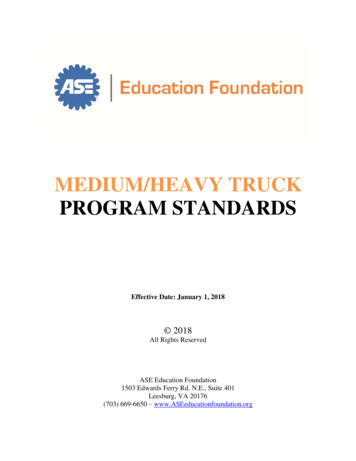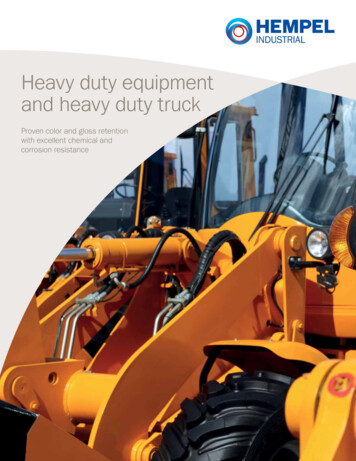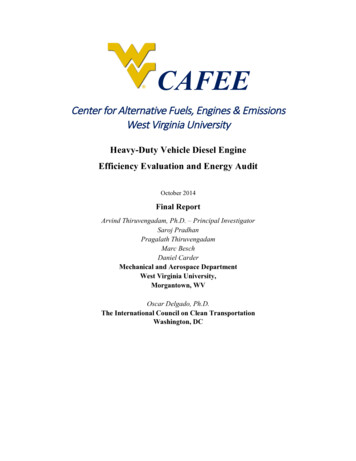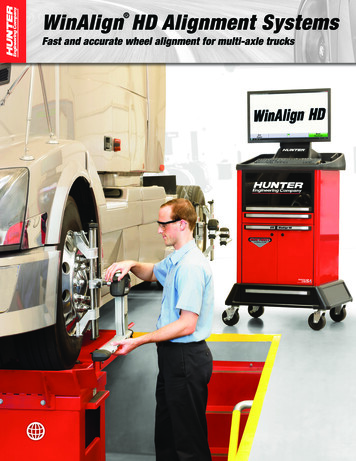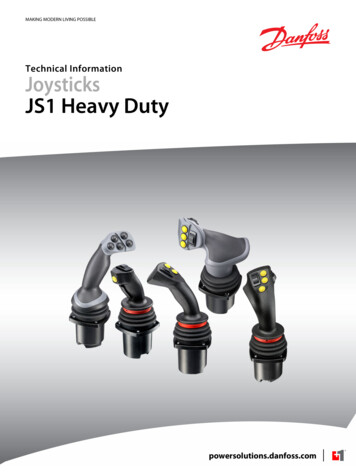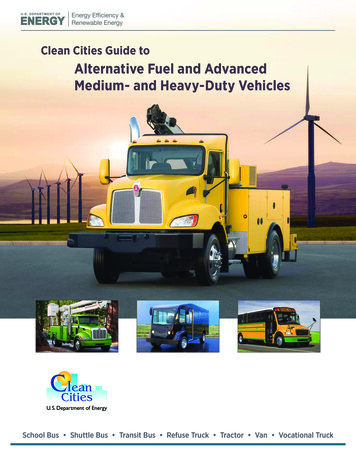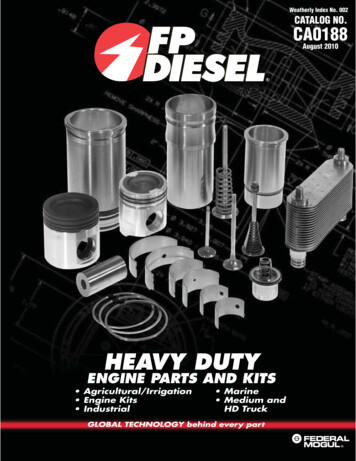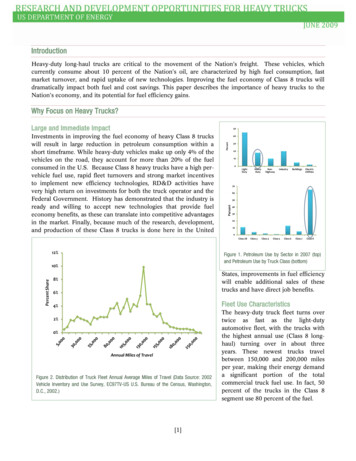
Transcription
IntroductionHeavy-duty long-haul trucks are critical to the movement of the Nation’s freight. These vehicles, whichcurrently consume about 10 percent of the Nation’s oil, are characterized by high fuel consumption, fastmarket turnover, and rapid uptake of new technologies. Improving the fuel economy of Class 8 trucks willdramatically impact both fuel and cost savings. This paper describes the importance of heavy trucks to theNation’s economy, and its potential for fuel efficiency gains.Why Focus on Heavy Trucks?Large and Immediate ectricUtilitiesClass 7Class 850403020100Class 3Class 4Class 5Class 6Figure 1. Petroleum Use by Sector in 2007 (top)and Petroleum Use by Truck Class (bottom)10%Percent ShareNonHighway70Class 2B12%HeavyDuty60PercentInvestments in improving the fuel economy of heavy Class 8 truckswill result in large reduction in petroleum consumption within ashort timeframe. While heavy-duty vehicles make up only 4% of thevehicles on the road, they account for more than 20% of the fuelconsumed in the U.S. Because Class 8 heavy trucks have a high pervehicle fuel use, rapid fleet turnovers and strong market incentivesto implement new efficiency technologies, RD&D activities havevery high return on investments for both the truck operator and theFederal Government. History has demonstrated that the industry isready and willing to accept new technologies that provide fueleconomy benefits, as these can translate into competitive advantagesin the market. Finally, because much of the research, development,and production of these Class 8 trucks is done here in the United406%States, improvements in fuel efficiencywill enable additional sales of thesetrucks and have direct job benefits.4%Fleet Use Characteristics8%2%0%Annual Miles of TravelFigure 2. Distribution of Truck Fleet Annual Average Miles of Travel (Data Source: 2002Vehicle Inventory and Use Survey, EC97TV-US U.S. Bureau of the Census, Washington,D.C., 2002.)[1]The heavy-duty truck fleet turns overtwice as fast as the light-dutyautomotive fleet, with the trucks withthe highest annual use (Class 8 longhaul) turning over in about threeyears. These newest trucks travelbetween 150,000 and 200,000 milesper year, making their energy demanda significant portion of the totalcommercial truck fuel use. In fact, 50percent of the trucks in the Class 8segment use 80 percent of the fuel.
Truck fuel cost is a key driver for adopting newtechnology. As Figure 3 shows, the lifetime fuel costfor an average passenger car is similar to thevehicle’s original purchase price. This is in greatcontrast to the Class 8 truck, where lifetime fuelcosts are around five times that of the originalpurchase price for the vehicle.Operator Return on InvestmentAs described above, fuel is often the number oneexpense for truck fleets: annual fuel cost for Class 8long-haul trucks can be in the range of 70,000 to 125,000. Because fleets operate on razor thin 1-2%profit margins, increased truck fuel economyFigure 3. Relative Fuel and Vehicle Costs for Cars and Heavy Trucks.increases the company’s profits, and dramaticallyimproves their chances of survival in tough businessclimates. For example, a 20 percent improvement in fuel economy can save 14,000 to 25,000 per year.With these large annual savings, paybacks for energy efficient technologies in Class 8 trucks can often be lessthan a single year – which is five to ten times shorterthan new technologies in passenger vehicles.Federal Return on InvestmentThe return on investment on the Federalgovernment’s funding of heavy vehicle research hasbeen excellent. The Federal return on investment isgreater than 60 to 1 ( 7.7 billion in fuel savings from 125 million in research funding) for technologiesdeveloped from Federal research between 1999 and2007 (benefits were calculated for model years 2004to 2008). This dramatic return on Federal investmentresulted in a national payback of approximately twomonths. In addition, because of the directFigure 4. Recent History in Truck Engine Efficiencyrelationship between fuel saved and greenhouse gasesavoided, these investments result in significant GHGemissions reductions of 25 million metric tons ofCO2. Vehicle operators have a negative cost ofavoiding greenhouse gases: they save about 256 foreach ton of CO2 reduced.Industry Willing to Adopt New TechnologyHistoric data have shown that DOE-sponsoredtechnologies have been quickly adopted within theheavy truck fleet. The graphic in Figure 4 shows theFigure 5. New Technology Can Penetrate Class 8 Truck Market ineffects of engine and emissions technologiesThree Yearsdeveloped in joint DOE/industry research efforts:these technologies were adopted by all major engine manufacturers and mitigated potential efficiencyreductions that could have resulted from meeting the 2007 emissions standards. At a company level,technologies can typically be implemented across a range of engine models within the first year. Nationally,[2]
technologies developed for the Class 8 market are typically implemented in three years or less, and quicklypenetrate into the Class 6 and 7 markets because of the similarity of these vehicle classes (see Figure 5).Domestic and International MarketsImplementing energy efficient technologies for heavy vehicles will have a significant impact on the nation’spetroleum consumption. According to the DOE Energy Information Administration’s Annual Energy Outlook(AEO) 2009, U.S. heavy truck fuel consumption will increase 23 percent between 2009 and 2020 (because ofeconomic growth drivers for freight transportation), while fuel use of light-duty vehicles will increase only 1percent over the same period (because of corporate average fuel economy regulations and other factorsdriving light-duty vehicle fuel efficiency gains). This will make heavy trucks a more significant portion of thetotal transportation fuel use picture, and will mean that heavy truck fuel efficiency will be even moreimportant in the future.Truck fuel efficiency research can have an effect on the world market as well. First, a portion of the usedtrucks from the U.S. market are sold into secondary markets in foreign countries, so if these used truckscontain advanced fuel efficiency technologies, they will provide benefits to these countries as well. In addition,worldwide energy demand continues to grow, especially in non-OECD countries like China and India. Thesecountries can benefit from the technologies developed and produced here in the U.S.Domestic JobsTrucking is critical to the domestic economy. Trucks haul 69percent of all freight tonnage, and collect 84 cents of everydollar spent on domestic freight transportation. There arealmost 9 million people in trucking-related jobs, includingover 3 million truck drivers. Many of these drivers are notpart of large fleets, but are independent owner-operators (87percent of fleets operate less than 6 trucks).Figure 6. Illustration of Truck and Engine Manufacturingin North AmericaAbout 15 percent of trucking jobs are in manufacturing, inplants across North America. The market for the productsresulting from this manufacturing effort is changing, asCaterpillar announced its withdrawal from the on-highwayengine market effective in 2010, but PACCAR is entering theengine market with its own engines to be produced at a newplant in Mississippi. Also, Navistar is expanding its ownengine offerings to sizes up to 15 liters (appropriate for Class8 over-the-road trucks).Lastly, it should be noted that most trucks used in the U.S. are designed for the North American market, incontrast to the light-duty market. At present, there is very little competition from imported vehicles because ofdiffering regulations and customer needs.[3]
A New Metric for Truck Fuel EfficiencyA critical issue with regard to truck fuel efficiency isthe metric used to measure it. Miles per gallon is themost common measure for fuel economy: it is verycommon for light-duty vehicles, and is shown onvehicle window stickers, corporate advertising, andfuel economy websites. It is used in the light-dutymarket for compliance with corporate average fueleconomy regulations, as well.When measuring the fuel economy of heavy dutytrucks it is a more meaningful measure to considerhow much freight is moved per gallon of fuel. Thisfuel efficiency metric is known as “freight efficiency”and is most commonly expressed on a weight basis(ton miles per gallon). Freight efficiency is a superiormetric because it recognizes the contribution of“avoided trips” to fuel savings (more freight pervehicle means fewer vehicles overall, typicallyresulting in fuel saved).Light-duty passenger carLight-duty truckU.S. Class 8 TruckAustralian Road Train050100150200250300Freight Efficiency (Ton-Miles per Gallon)Figure 7. Sample Freight Efficiencies. (NOTE: The Road Train is atrucking concept used in Australia, similar to U.S. turnpike doubles.This concept uses a single Class 8 tractor to pull two or threestandard semitrailers to increase the total cargo capacity pulled byeach tractor.)Some sample freight efficiencies (in ton miles per gallon) are shown in Figure 7. Note that a light-duty truck,despite its significantly higher miles per gallon than a Class 8 truck, achieves much lower freight efficiencybecause of its limited cargo capacity relative to the Class 8 truck.R&D Opportunities for Heavy TrucksOverviewOpportunities for increasing the freightefficiency of heavy trucks could entailimproving the energy efficiency of Class 8trucks, implementing new logistics technologyto minimize empty or partly-loaded trucks andrevisiting regulations that unnecessarily limitthe size, shape and configurations of long-haulClass 8 trucks. Areas to be considered fortechnology R&D include improving enginesystems, aerodynamics, tire rolling resistance,idle reduction, and drivetrain optimization(including hybridization).Figure 8. Energy Balance of Typical Class 8 Tractor/Semitrailer CombinationUnitA transformed truck system is required torealize significant savings, and requires thatthe truck and trailer be considered as acomplete system, addressing all the significant areas of energy use as shown in Figure 8. As this figureillustrates, there are potential technology solutions for each of the truck’s major components. Some specifictechnology opportunities for truck systems are listed below:[4]
Engine: advanced combustion, waste heat recovery (bottoming cycles, turbocompounding,thermoelectrics, etc.), friction and wear reduction, optimized aftertreatmentAerodynamic drag: trailer gap reduction (on tractor or trailer), trailer wake treatments, trailer side skirtsDrivetrain optimization: friction and wear reduction, hybridization (even for Class 8 long haul)Accessory load reduction: electrification of accessory loads like power steering and air conditioning(synergistic with electric hybrid technologyBarriers to SuccessThere are several barriers of a technology or market nature that would hinder the success of future efficiencyimprovement efforts. These barriers will need to be addressed through technology R&D.Engine/advanced combustionA solid fundamental knowledge of engine combustion is needed to enable additional engine efficiencyimprovements and minimize risk in developing these improvements, especially with more advancedcombustion techniques like homogeneous-charge compression ignition (HCCI). Robust and effectiveemission control devices that enable compliance with prevailing emission standards with minimal impact onfuel efficiency are needed. More advanced and sophisticated engine control strategies and equipment areneeded to enable use of low-temperature combustion for high efficiency and low emissions.Advanced energy storageFor hybrid or idle reduction systems, efficient and durable energy storage is needed. Advanced batterychemistries will need to be explored: truck duty cycles and power requirements are very different from thoseexperienced with light-duty vehicles.Advanced materialsFor lightweight and durable tractors and trailers, advanced lightweighting materials will be needed, like lowcost carbon fiber.Truck systemsTrucks are already efficient at freightLogistics & Freight MovementRegulations and Public policymovement, so making transformational Load management/backloads Road Speed limiting Route Optimization Weight limitsstrides in efficiency will require a radical Congestion Avoidance Trailer combinations Distance Minimizationrethinking of all aspects of truck design Length limits Vehicle management Driver Hours of Service(integration of truck and trailer designs for Road speed limiting Congestion mitigation Driver management Incentives (hybrid)aerodynamics, rethinking of truck structure, Smart gearing Education and support Acceleration controletc.) Truck manufacturing, while more EPA SmartWay program Idle managementintegrated than in the past, still involvesState-to-state inconsistency is a Smart Navigation via GPS & communication(anticipating grades, speed limit changes,major barrier to efficient freightmany separate manufacturing entitiescongestion, etc.)movement. Intermodal (truck, rail, water)(truck OEMs, engine manufacturers, Tier 1Significant gains have been Manufacturing and distribution strategiesrealized in logistics. Still Packagingsuppliers, trailer manufacturers, truck bodyroom for improvement Right-sizing – optimizing vehicle size to loadmanufacturers). Trucks, especially Class 8trucks, are almost custom-made: systemsFigure 9. Key Factors in HD Truck Efficiency Regulation and Logisticsintegration is a complex issue that mightinvolvemultipleengines,multipledrivelines, multiple aero configurations, etc. For Class 8 long-haul trucks, analysis has shown there is muchopportunity in trailer aerodynamics: however, there is much less incentive for trailer energy efficiencytechnologies (inexpensive trailers, mismatch of benefits and investor – the trailer owner who pays for thetechnology and the truck owner who benefits from the fuel savings). Regulatory changes may be required:[5]
increased size and weight for Class 8 trucks (for improved freight efficiency), national speed limit regulationsfor trucks, consistent idling reduction regulations, etc. (see Figure 9).Potential BenefitsThe chart in Figure 10 shows thepotential benefits to the Nation ofone possible set of R&D efforts. Thebenefits are composed of three majorcomponents, also shown in theFigure:engine-relatedbenefits(direct engine efficiency, waste heatrecovery, and so forth); efits (changes in truck size andweightregulations,loadmanagement, speed limiters, etc.)Figure 10. SuperTruck Potential Benefits – DOE’s View[6]
Duty Heavy Duty Non-Highway Industry Buildings Electric Utilities 0 10 20 30 40 50 60 70 Class 2B Class 3 Class 4 Class 5 Class 6 Class 7 Class 8 Percent. Figure 2. Distribution of Truck Fleet Annual Average Miles of Travel (Data Source: 2002 Vehicle Inventory and Use Survey, EC97US U.S. Bure

